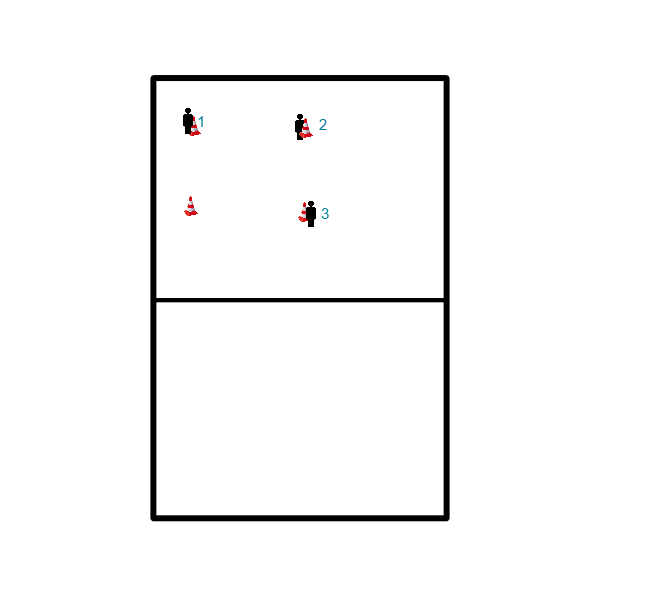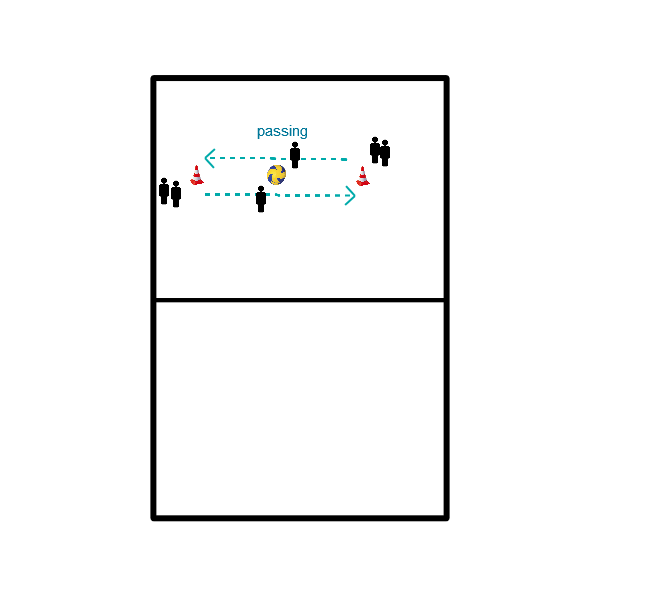Korfball exercises for u12
Inshort: practise various forms of the shot in a fun competition format.
Organisation: each group a basket and a ball, the baskets are preferably (but not absolutely necessary) arranged in a circle or rectangle. The number of people per group is less important (all groups should be about the same size).
Pawns set up at 1,3,5 metres
The first assignment for the groups is: make 10 goals. When you are done, the creator of the last goal goes to the trainer to get the next assignment. Which group will have completed all assignments first?
The trainer walks around the room, encouraging or correcting the players. He has a piece of paper with a list of assignments. When someone comes to get the next assignment, first ask him which assignment he just completed (after a while this can vary considerably) and then give the next one. Here's an example: 10 walk-through balls, 15 penalty shots, 5 shots from 8 meters, 10 walk-through balls from behind the basket, 5 dodgeballs next to the post, 10 shots from 6 meters. Everything is possible of course, a lot of momentum comes from keeping the number of goals to be scored small.
Tasks:
- 6 scores from 2,5 meter in front of the basket
- 6 scores from 1 meter in front of the basket
- 6 scores from 6 meter in front of the basket
- 6 scores from 2,5 meter behind the basket
- 6 scores from 1 meter behind the basket
- 6 scores from 6 meters behind the basket
Start line-up
Two groups at the first two pawns.
Exercise
The first in line runs to the hoop and goes through the hoop from the bottom, so the hoop goes over their heads. Then he runs through the defence posture to pawn two and circles this in 4 circles. Finally, he runs to pawn 3 and scores before he can run back to pawn 1 and tap the next one in line.
Distance set up:
- Hoop from pawn 1: 5 meters.
- Pawn 2 from the hoop: 5 meter.
- Pawn 3 from pawn 2: 5 meter.
- Pole from cone 3: 4 meter.


In short:
A trio has to pass the ball to each other in a square.That is tricky yes, because one is always missing....
Organisation:
Three players stand in an imaginary square about eight metres from each other. One corner remains unoccupied. The middle player (number 2) of the three has the ball.
Start in square. In from (basic
) Later: 1 under the post.
Basis: always offer sides. Not in a clump, not too early, not too late.
Setup: O v * * = pilon O = basket
* v O
[Make
sure that they first pass the ball before passing it.
Distance between the pile and the basket is +/- 10 meterAt
each pile there is one person with the ballAt
+/- 4 meter from the pile there is one defender.
The player tries to pass the ball. By changing tempo she tries to pass the defender first. Defender follows, but lets her pass. From pole 1 the attacker moves on to pole 2 and makes a new attempt at pole 2.
Variation:
- 2 attackers at the same time
- When scoring twice, switch to pass.
- Defender goes for preventing shot.
- Attacker can choose for walk through, dodge and/or distance with step behind
- adjust time
- multiple posts/pillars/players
Inshort: simple catching and throwing exercise with a lot of running for foursome.
Organisation: The four players form a square (distance about 10 metres, depending on the level), one of the four has a ball. If there are people left over, one or more foursomes can be formed and stand in a pentagon. Almost all parts of the exercise described above can be practised in this form of organisation.
The procedure is as follows:
Player A throws the ball to B, runs after him, gets the ball back and throws to C. He gets the ball back, plays to D, gets the ball back and throws to B over quite a distance, and finally takes his original place again. In the meantime B has already started his round. When everyone in every foursome has had 3 turns the next exercise comes.
Variations:
- The players walk the other way.
- The attackers move slightly to and fro.
- Which foursome will finish fastest? (everyone has to walk three times).
- Make sure that the distances do not suddenly get smaller!
Inshort: exercises in catching balls that bounce or roll at the right moment.
Organisation: One ball per pair or trio.
- The numbers 1 and 2 of each pair stand next to each other. Number 1 rolls the ball a few metres away. Number 2 has to get the ball, pick it up and throw it back as quickly as possible. Change after 5 games. Make sure that the players 'get' the ball as quickly as possible by putting one hand on it as soon as possible.
- Like 1., but now number 1 throws the ball away with a small curve, in such a way that it bounces about 4 metres away (and then makes a bounce of about half a metre high). Number 2 must try to get the ball as soon as possible after the bounce.
- As 2, but now number 1 drops the ball from 1.5 metres just in front of number 2. Number 2 must again try to get the ball as soon as possible after the bounce. It will appear that almost everyone lets the ball rise a little before catching it. Wrong (in the meantime an opponent can quickly put his/her hand on the ball). At the very moment that the ball is about to come up, the hand should be placed on the ball Get that ball!
- Three teams, the person who gives the information stands in the middle. He rolls the ball a few meters away. As soon as the ball is loose, the other two may run. Who has the ball first? After 3 substitutions.
Let's get used to the field.
Three poles in a triangle. Three running players. From the pillon you push. Remember technique.
1) take a walk through ball. Scoring three is substitution2
) Take neighbourhood ball. Scoring one is exchanging3)
Walk through ball overhead4
) Walk through ball backwards5
) score 10 together.
Setup: O v * * = pilon O = basket
* v O
- Distance between the pile and the basket is +/- 10 meter.
- At every pole stands 1 attacker with the ball.
- At 1 meter from the pylon stands 1 defender (you must be able to touch the attacker by the shoulder).
- The player tries to pass the ball.
- By changing tempo she tries to pass the defender first.
- Defender follows, but lets her pass.
- From pole 1 the attacker continues to pole 2 and makes a new attempt at pole 2.
- We do this for 1 to 2 minutes per person.
Variation:
- 2 attackers at the same time
- When scoring twice, switch to pass.
- Defender goes for preventing shot. Attackers can choose for walk through ball, dodge and/or distance with step behind.
- adjust time
- Multiple posts/pillars/players.

- Place the hats about 6 meters apart. Divide the group in 2.
- In case of five a group of three and a group of two.
- Goal is to keep the ball in the middle of the hats at all times.
- As soon as a player receives the ball, the player from the other side must be at the same level as the middle.
- After passing the ball, join the back of the queue at the other side.
- NB: nobody stands still and estimate well.
- Do not arrive too early or too late.
- Throw from the move.
- After five minutes also go the other way (left hand side).
Practice with 4 players the free ball. Use 3 persons for the attack. Person 1 takes the free ball, person 2 and 3 pass. Person 4 defends the free ball on person 1.
- pass under the basket
- pass next to basket
- Attacker moves away from the basket and shoots directly.
- 1 attacker throws the ball to the person in front of the basket then he shoots the ball when he catches the ball under the basket he then goes inside and takes a walkthrough ball finally he takes a short chance.
- Point count:
- Shot counts 2x
- Walkthrough counts 1x
- Short chance counts 1x
- You can play this like this, for example, who is first to the 20 or
- 1min long and then look per basket who has the most points
! Form groups of 2 people per basket
Each group receives three cards. The cards are shuffled beforehand and the numbers 2 to 5 are taken from the packet. With the three cards they receive, the groups must get as close as possible to 31. The values of the numbers and pictures are shown below:
- Six = six
- Seven = seven
- Eight = eight
- Nine = nine
- Ten is ten
- Farmer = ten
- Wife = ten
- King = ten
- Ace = eleven
So nine + jack + queen = 29 points or ace + jack + queen = 31, but you can also get jack + jack = 30.5
When the players have completed a series, they may exchange one of their received cards for a new one, to get closer to 31. The trainer sets a timer and says stop when it rings. The team that is closest to 31 wins.
Series:
- Pass balls: three goals in a row.
- Short chance: four goals in total.
- Distance shot behind the basket: two goals in a row (4/5 meters).
- Penalty throw: three goals in a row.
- Around the basket: four goals, one on each side of the basket (3 metres).








